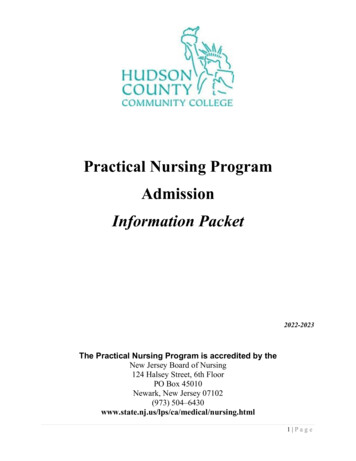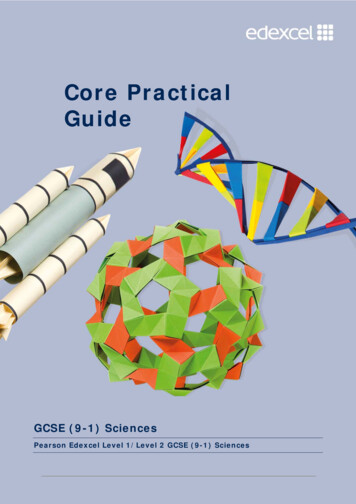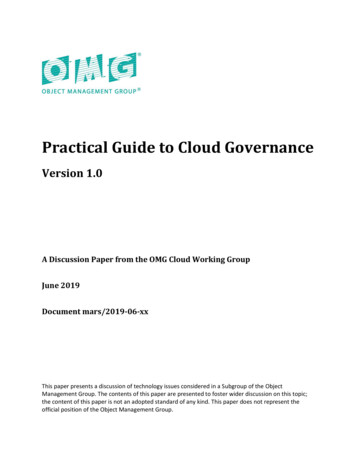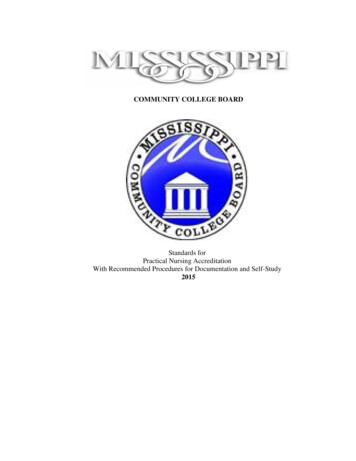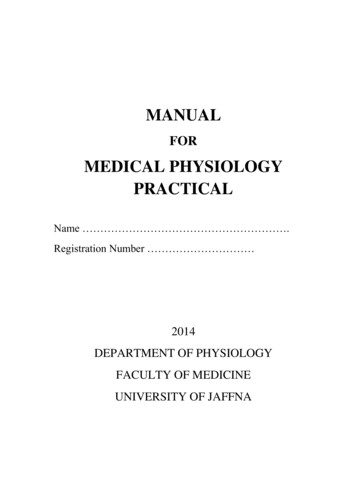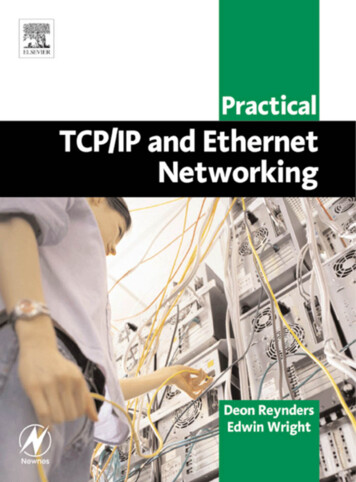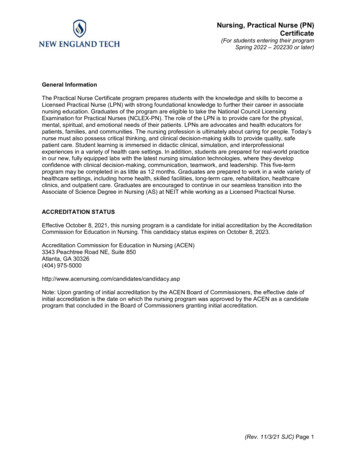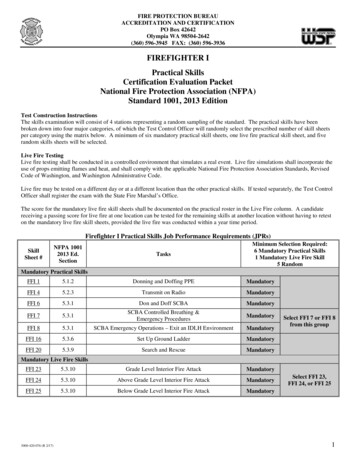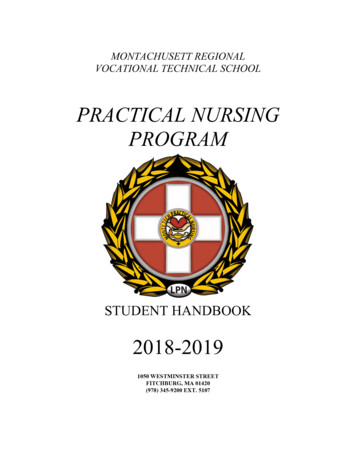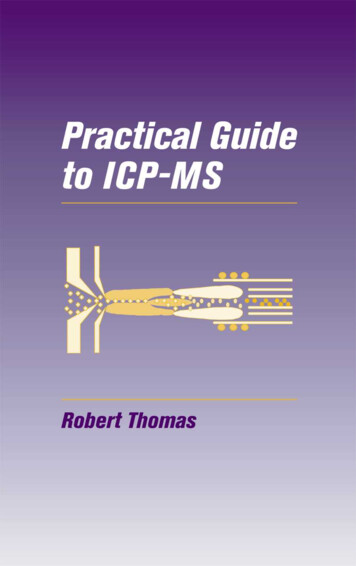
Transcription
Practical Guideto ICP-MSRobert ThomasScientific SolutionsGaithersburg, Maryland, U.S.A.MARCELMARCELDEKKER,INC.DEKKERNEWYORK BASEL
Although great care has been taken to provide accurate and current information,neither the author(s) nor the publisher, nor anyone else associated with this publication, shall be liable for any loss, damage, or liability directly or indirectly caused oralleged to be caused by this book. The material contained herein is not intended toprovide specific advice or recommendations for any specific situation.Trademark notice: Product or corporate names may be trademarks and are used onlyfor identification and explanation without intent to infringe.Library of Congress Cataloging-in-Publication DataA catalog record for this book is available from the Library of Congress.ISBN: 0-8247-5319-4This book is printed on acid-free paper.HeadquartersMarcel Dekker, Inc., 270 Madison Avenue, New York, NY 10016, U.S.A.tel: 212-696-9000; fax: 212-685-4540Distribution and Customer ServiceMarcel Dekker, Inc., Cimarron Road, Monticello, New York 12701, U.S.A.tel: 800-228-1160; fax: 845-796-1772Eastern Hemisphere DistributionMarcel Dekker AG, Hutgasse 4, Postfach 812, CH-4001 Basel, Switzerlandtel: 41-61-260-6300; fax: 41-61-260-6333World Wide Webhttp://www.dekker.comThe publisher offers discounts on this book when ordered in bulk quantities. For moreinformation, write to Special/Professional Marketing at the headquarters addressabove.Copyright n 2004 by Marcel Dekker, Inc. All Rights Reserved.Neither this book nor any part may be reproduced or transmitted in any form or byany means, electronic or mechanical, including photocopying, microfilming, andrecording, or by any information storage and retrieval system, without permissionin writing from the publisher.Current printing (last digit):10 9 8 7 6 5 4 3 2 1PRINTED IN THE UNITED STATES OF AMERICA
PRACTICAL SPECTROSCOPYA SERIES1. Infrared and Raman Spectroscopy (in three parts), edited by Edward G.Brame, Jr., and Jeanette G. Grasselli2. X-Ray Spectrometry, edited by H. K. Herglofz and L. S. Birks3. Mass Spectrometry (in two parts), edited by Charles Merriff, Jr., and CharlesN. McEwen4. Infrared and Raman Spectroscopy of Polymers, H. W. Siesler and K.Holland-Moritz5. NMR Spectroscopy Techniques, edited by Cecil Dybowski and Robert L.Lichter6. Infrared Microspectroscopy: Theory and Applications, edited by Robert G.Messerschmidtand Maffhew A. Harthcock7. Flow Injection Atomic Spectroscopy, edited by Jose Luis Burguera8. Mass Spectrometry of Biological Materials, edited by Charles N. McEwenand Barbara S. Larsen9. Field Desorption Mass Spectrometry,Laszlo Prokai10. Chromatography/Fourier Transform Infrared Spectroscopy and Its Applications, Robert White11. Modern NMR Techniques and Their Application in Chemistry, edited byAlexander 1. Popov and Klaas Hallenga12. LuminescenceTechniques in Chemical and BiochemicalAnalysis, edited byWilly R. G. Baeyens, Denis De Keukeleire, and KatherineKorkidis13. Handbook of Near-InfraredAnalysis, edited by DonaldA. Bums and mil W.Ciurczak14. Handbook of X-Ray Spectrometry: Methods and Techniques, edited by Rene . Van Grieken and Andtzej A. Markowicz15. Internal Reflection Spectroscopy: Theory and Applications, edited by FrancisM. Mirabella, Jr.16. Microscopic and Spectroscopic Imaging of the Chemical State, edited byMichael D. Morns17. MathematicalAnalysis of Spectral Orthogonality, John H. Kalivas and PatrickM. Lang18. Laser Spectroscopy: Techniques and Applications, E. Roland Menzel19. Practical Guide to Infrared Microspectroscopy, edited by Howard J. Humecki20. Quantitative X-ray Spectrometry: Second Edition, Ron Jenkins, R. W. Gould,and Dale Gedcke21. NMR Spectroscopy Techniques: Second Edition, Revised and Expanded,edited by Martha D. Bruch22. Spectrophotometric Reactions, lrena Nemcova, Ludmila Cermakova, and JiriGasparic23. Inorganic Mass Spectrometry: Fundamentals and Applications, edited byChristopherM. Barshick, Douglas C. Duckwotth, and David H. Smith24. Infrared and Raman Spectroscopy of Biological Materials, edited by HansUlrich Gremlich and Bing Yan
25. Near-Infrared Applications in Biotechnology, edited by Ramesh Raghavachari26. Ultrafast Infrared and Raman Spectroscopy, edited by M. D. Fayer27. Handbook of Near-Infrared Analysis: Second Edition, Revised and Expanded, edited by Donald A. Bums and mil W. Ciurczak28. Handbook of Raman Spectroscopy: From the Research Laboratory to theProcess Line, edited by Ian R. Lewis and Howell G. M. Edwards29. Handbook of X-Ray Spectrometry: Second Edition, Revised and Expanded,edited by Rene E. Van Grieken and Andrzej A. Markowicz30. Ultraviolet Spectroscopy and UV Lasers, edited by Prabhakar Misra andMark A. Dubinskii31. Pharmaceutical and Medical Applications of Near-Infrared Spectroscopy, mil W. Ciurczak and James K. Drennen 11132. Applied Electrospray Mass Spectrometry, edited by Birendra N. Pramanik, A.K. Ganguly, and Michael L. Gross33. Practical Guide to ICP-MS, Robert ThomasADDITIONAL VOLUMES IN PREPARATION
To my ever supportive wife, Donna Marie, and my two precious daughters,Deryn and Glenna.iii
ForewordMilestones mark great events: walking on the moon, analyzing rocks onMars, flying a self-propelled, heavier-than-air machine, using a Bunsenburner for flame atomic spectrometry, and perhaps employing an atmospheric pressure plasma mass spectrometry as an ion source for solution massspectrometry. Yes, inductively coupled plasma mass spectrometry (ICP-MS)ranks among the milestone inventions of spectrochemical analysis during the20th century. The great event of ICP-Ms, however, is the enrichment ofquantitative ultratrace element and isotope analysis capabilities that hasbecome possible on a daily, routine basis in modern analytical, clinical,forensics, and industrial laboratories. During the past 20 years ICP-MS hasgrown from R. Sam Houk’s Ph.D. research project at the Ames Laboratoryon the Iowa State University campus to an invaluable tool fabricated on manycontinents and applied internationally. Although ICP-MS does not share theuniversal practicality of the electric light, the laser, or the transistor, it ranks inanalytical chemistry along with the development of atomic absorptionspectrophotometry, coulometry, dc arc and spark emission spectrography,gravimetry, polarography, and titrimetry.What can we expect to find in a new technical book, especially onedescribing ICP-MS in few hundred pages? Do we anticipate a refreshingapproach to a well-established topic, answers to unsolved questions, clearinsights into complicated problems, astute reviews and critical evaluations ofdevelopments, and meaningful consideration of areas for future advancement? We would be satisfied if any of these goals were achieved. Today librarybookshelves bear the weight of the writing efforts of numerous recognizedresearchers and a few practitioners of ICP. Some of these works deserve tostay in the library, while very few others are kept at hand on the analyst’s desk,with stained pages and worn bindings as evidence of their heavy use. Thisvolume is intended to be among the latter.v
viForewordPractical Guide to ICP-MS started as a series of brief tutorial articles(‘‘A Beginner’s Guide to ICP-MS’’) appearing in Spectroscopy magazine(Eugene, Oregon; www.spectroscopyonline.com), beginning in April 2001,and it retains the earthy feeling and pragmatism of these monthly contributions. These popular articles were refreshingly straightforward and technically realistic. Presented in an informal style, they reflected the author’s yearsof practical experience on the commercial side of spectroscopic instrumentation and his technical writing skills. Almost immediately I incorporated theminto my own spectroscopy teaching programs.Practical Guide to ICP-MS builds upon this published series. WhatRobert Thomas has assembled in this volume is 21 chapters that start withbasic plasma concepts and ICP-MS instrument component descriptions andconclude with factors to be considered in selecting ICP-MS instruments.Chapters 2 through 16 closely follow the Spectroscopy magazines articles I–XII (2001–2002), and Chapter 19 reflects articles XIII and XIV (February2003). The remaining five chapters comprise others materials, includingcontamination issues, routine maintenance, prevalent applications areas,comparison with other atomic spectroscopy methods (also adapted fromtwo previously published magazine articles), selection of an ICP-MS system,and contact references.This is not a handbook describing how to prepare a sample for traceelement analysis, perform an ICP-MS measurement. or troubleshoot practical ICP systems. Although these topics urgently need to be addressed, thisbook is intended to get readers started with ICP-MS. It highlights everythingfrom basic component descriptions and features to guidelines describingwhere and when using ICP-MS is most appropriately employed. The informalwriting style, often in the first person, conveys the author’s involvement withICP product development and his experience with practical applications andmakes this text very readable. Consequently, I look forward to seeing thisbook used in may training programs, classrooms, and analysis laboratories.Ramon M. BarnesDirectorUniversity Research Institute for Analytical ChemistryAmherst, Massachusetts, U.S.A.andProfessor EmeritusDepartment of ChemistryLederle Graduate Research Center TowersUniversity of MassachusettsAmherst, Massachusetts, U.S.A.
PrefaceTwenty years after the commercialization of inductively coupled plasma massspectrometry (ICP-MS) at the Pittsburgh Conference in 1983, approximately5,000 systems have been installed worldwide. If this is compared with anotherrapid multielement technique, inductively coupled plasma optical emissionspectrometry (ICP-OES), first commercialized in 1974, the difference is quitesignificant. As of 1994, 20 years after ICP-OES was introduced, about 12,000units had been sold, and if this is compared with the same time period forwhich ICP-MS has been available the difference is even more staggering.From 1983 to the present day, approximately 25,000 ICP-OES systems havebeen installed—about 5 times more than the number of ICP-MS systems. Ifthe comparison is made with all atomic spectroscopy instrumentation (ICPMS, ICP-OES, Electrothermal Atomization [ETA], and flame atomic absorption [FAA]), the annual sales for ICP-MS are less than 7% of the total ASmarket—500 units compared with approximately 7000 AS systems. It’s evenmore surprising when one considers that ICP-MS offers so much more thanthe other techniques, including superb detection limits, rapid multielementanalysis and isotopic measurement capabilities.ICP-MS: RESEARCH OR ROUTINE?Clearly, one of the many reasons that ICP-MS has not become more popularis its relatively high price-tag—an ICP mass spectrometer typically cost 2times more than ICP-OES and 3 times more than ETA. But in a competitiveworld, the street price of an ICP-MS system is much closer to a top-of-the-lineICP-OES with sampling accessories or an ETA system that has all the bellsand whistles on it. So if ICP-MS is not significantly more expensive than ICPOES and ETA, why hasn’t it been more widely accepted by the analyticalcommunity? The answer may lie in the fact that it is still considered a complicated research-type technique, requiring a very skilled person to operate it.vii
viiiPrefaceManufacturers of ICP-MS equipment are constantly striving to make the systems easier to operate, the software easier to use and the hardware easier tomaintain, but even after 20 years, it is still not perceived as a mature, routinetool like flame AA or ICP-OES. This might be partially true because of therelative complexity of the instrumentation. However, could the dominantreason for this misconception be the lack of availability of good literatureexplaining the basic principles and application benefits of ICP-MS, in a waythat is compelling and easy to understand for a novice who has limitedknowledge of the technique? There are some excellent textbooks (1–3) andnumerous journal papers (4,5,6) available describing the fundamentals, butthey are mainly written or edited by academics who are not approaching thesubject from a practical perspective. For this reason, they tend to be far tooheavily biased toward basic principles and less toward how ICP-MS is beingapplied in the real-world.PRACTICAL BENEFITSThere is no question that the technique needs to be presented in a morepractical way, in order to make routine analytical laboratories more comfortable with it. Unfortunately, the publisher of the Dummies series has not yetfound a mass market for a book on ICP-MS. This is being a little facetious, ofcourse, but, from the limited number of ICP-MS reference books availabletoday, it is clear that a practical guide is sadly lacking. This was most definitelythe main incentive for writing the book. However, it was also felt that to painta complete picture for someone who is looking to invest to ICP-MS, it wasvery important to compare its capabilities with those of other common traceelement techniques, such as FAA, ETA, and ICP-OES, focusing on suchcriteria as elemental range, detection capability, sample throughput, analytical working range, interferences, sample preparation, maintenance issues,operator skill level, and running costs. This will enable the reader to relate thebenefits of ICP-MS to those of other more familiar atomic spectroscopy instrumentation. In addition, in order to fully understand its practical capabilities, it is important to give an overview of the most common applicationscurrently being carried out by ICP-MS and its sampling accessories, to give aflavor of the different industries and markets that are benefiting from thetechnique’s enormous potential. And finally, for those who might be interested in purchasing the technique, the book concludes with a chapter on themost important selection criteria. This is critical ingredient in presenting ICPMS to a novice, because there is very little information in the public domain tohelp someone carry out an evaluation of commercial instrumentation. Veryoften, people go into this evaluation process completely unprepared and as aresult may end up with an instrument that is not ideally suited for their needs.
PrefaceixThe main objective is to make ICP-MS a little more compelling topurchase and ultimately open up its potential to the vast majority of the traceelement community who have not yet realized the full benefits of its capabilities. With this in mind, please feel free to come in and share one person’sview of ICP-MS and its applications.ACKNOWLEDGMENTSI have been working in the field of ICP mass spectrometry for almost 20 yearsand realized that, even though numerous publications were available, notextbooks were being written specifically for beginners with a very limitedknowledge of the technique. I came to the conclusion that the only way thiswas going to happen was to write it myself. I set myself the objective of puttingtogether a reference book that could be used by both analytical chemists andsenior management who were experienced in the field of trace metals analysis,but only had a basic understanding of ICP-MS and the benefits it had to offer.This book represents the conclusion of that objective. So now after two yearsof hard work, I would like to take this opportunity to thank some of thepeople and organizations that have helped me put the book together. First, Iwould like to thank the editorial staff of Spectroscopy magazine, who gave methe opportunity to write a monthly tutorial on ICP-MS back in the spring of2001, and also allowed me to use many of the figures from the series-this wasmost definitely the spark I needed to start the project. Second, I would like tothank all the manufacturers of ICP-MS instrumentation, equipment, accessories, consumables, calibration standards and reagents, who supplied mewith the information, data, drawings and schematics etc. It would not havebeen possible without their help. Third, I would like to thank Dr. RamonBarnes, Director of the University Research Institute for Analytical Chemistry and organizer/chairman of the Winter Conference on Plasma Spectrochemistry for the kind and complimentary words he wrote in the Foreword—they were very much appreciated. Finally, I would like to thank my trulyinspirational wife, Donna Marie, for allowing me to take up full-time writingfour years ago and particularly for her encouragement over the past two yearswhile writing the book. Her support was invaluable. And I mustn’t forget mytwo precious daughters, Glenna and Deryn, who kept me entertained andamused, especially during the final proofing/indexing stage when I thought Iwould never get the book finished. I can still hear their words of wisdom,‘‘Dad, it’s only a book.’’FURTHER READING1.Inductive by Coupled Plasma Mass Spectrometry: A. Montasser, George Washington University, Wiley-VCH, New York, 1998.
xPreface2.Handbook of Inductively Coupled Plasma Mass Spectrometry: K. E. Jarvis, A. L.Gray and R. S. Houk, Blackie, Glasgow, 1992.Inorganic Mass Spectrometry, F. Adams, R. Gijbels, R. Van Grieken, Universityof Antwerp, Wiley and Sons, New York, 1988.R.S. Houk, V. A. Fassel and H. J. Svec, Dynamic Mass Spec. 6, 234, 1981.A.R. Date and A.L. Gray, Analyst, 106, 1255, 1981.D. J. Douglas and J. B. French, Analytical Chemistry, 53, 37, 1982.3.4.5.6.Robert Thomas
ContentsForeword Ramon M. BarnesPrefacevvii1. An Overview of ICP–Mass Spectrometry12. Principles of Ion Formation73. Sample Introduction134. Plasma Source235. Interface Region316. The Ion Focusing397. Mass Analyzers: Quadrupole Technology498. Mass Analyzers: Double-Focusing Magnetic SectorTechnology619. Mass Analyzers: Time of Flight Technology7110. Mass Analyzers: Collision/Reaction Cell Technology8111. Detectors9112. Peak Measurement Protocol10113. Methods of Quantitation117xi
xiiContents14. Review of Interferences12915. Contamination Issues14916. Routine Maintenance Issues16517. Alternate Sampling Accessories17918. ICP–MS Applications20719. Comparing ICP–MS with Other Atomic SpectroscopicTechniques24520. How to Select an ICP–Mass Spectrometer: SomeImportant Analytical Considerations26321. Useful Contact Information305Index315
1An Overview of ICP–Mass SpectrometryInductively coupled plasma mass spectrometry (ICP-MS) not only offers extremely low detection limits in the sub parts per trillion (ppt) range, but alsoenables quantitation at the high parts per million (ppm) level. This uniquecapability makes the technique very attractive compared to other trace metaltechniques such as electrothermal atomization (ETA), which is limited to determinations at the trace level, or flame atomic absorption (FAA) and inductively coupled plasma optical emission spectroscopy (ICP-OES), which aretraditionally used for the detection of higher concentrations. In Chapter 1, wewill present an overview of ICP-MS and explain how its characteristic lowdetection capability is achieved.Inductively coupled plasma mass spectrometry (ICP-MS) is undoubtedly thefastest-growing trace element technique available today. Since its commercialization in 1983, approximately 5000 systems have been installed worldwide, carrying out many varied and diverse applications. The most commonones, which represent approximately 80% of the ICP-MS analyses beingcarried out today, include environmental, geological, semiconductor, biomedical, and nuclear application fields. There is no question that the majorreason for its unparalleled growth is its ability to carry out rapid multielement determinations at the ultra trace level. Even though it can broadlydetermine the same suite of elements as other atomic spectroscopical techniques, such as flame atomic absorption (FAA), electrothermal atomization(ETA), and inductively coupled plasma optical emission spectroscopy (ICPOES), ICP-MS has clear advantages in its multielement characteristics,speed of analysis, detection limits, and isotopic capability. Figure 1.1 showsapproximate detection limits of all the elements that can be detected by ICPMS, together with their isotopic abundance.1
2Chapter 1FIGURE 1.1 Detection limit capability of ICP-MS. (Courtesy of Perkin-Elmer Lifeand Analytical Sciences.)PRINCIPLES OF OPERATIONThere are a number of different ICP-MS designs available today, whichshare many similar components, such as nebulizer, spray chamber, plasmatorch, and detector, but can differ quite significantly in the design of theinterface, ion focusing system, mass separation device, and vacuum chamber. Instrument hardware will be described in greater detail in the subsequent chapters, but first let us start by giving an overview of the principles ofoperation of ICP-MS. Figure 1.2 shows the basic components that make upan ICP-MS system. The sample, which usually must be in a liquid form, ispumped at 1 mL/min, usually with a peristaltic pump into a nebulizer, whereit is converted into a fine aerosol with argon gas at about 1 L/min. The finedroplets of the aerosol, which represent only 1–2% of the sample, are separated from larger droplets by means of a spray chamber. The fine aerosolthen emerges from the exit tube of the spray chamber and is transported intothe plasma torch via a sample injector.It is important to differentiate the roll of the plasma torch in ICP-MScompared to ICP-OES. The plasma is formed in exactly the same way, by
An Overview of ICP–Mass Spectrometry3FIGURE 1.2 Basic instrumental components of an ICP mass spectrometer.the interaction of an intense magnetical field [produced by radiofrequency(RF) passing through a copper coil] on a tangential flow of gas (normallyargon), at about 15 L/min flowing through a concentrical quartz tube(torch). This has the effect of ionizing the gas and, when seeded with asource of electrons from a high-voltage spark, forms a very-high-temperature plasma discharge (f10,000 K) at the open end of the tube. However,this is where the similarity ends. In ICP-OES, the plasma, which is normallyvertical, is used to generate photons of light, by the excitation of electrons ofa ground-state atom to a higher energy level. When the electrons ‘‘fall’’ backto ground state, wavelength-specific photons are emitted, which are characteristic of the element of interest. In ICP-MS, the plasma torch, which ispositioned horizontally, is used to generate positively charged ions and notphotons. In fact, every attempt is made to stop the photons from reachingthe detector because they have the potential to increase signal noise. It is theproduction and the detection of large quantities of these ions that give ICPMS its characteristic low parts per trillion (ppt) detection capability—aboutthree to four orders of magnitude better than ICP-OES.Once the ions are produced in the plasma, they are directed into themass spectrometer via the interface region, which is maintained at a vacuumof 1–2 Torr with a mechanical roughing pump. This interface region consistsof two metallic cones (usually nickel), called the sampler and a skimmer cone,each with a small orifice (0.6–1.2 mm) to allow the ions to pass through to theion optics, where they are guided into the mass separation device.The interface region is one of the most critical areas of an ICP massspectrometer because the ions must be transported efficiently and with electrical integrity from the plasma, which is at atmospheric pressure (760 Torr)
4Chapter 1to the mass spectrometer analyzer region at approximately 10 6 Torr.Unfortunately, there is capacitive coupling between the RF coil and theplasma, producing a potential difference of a few hundred volts. If this werenot eliminated, it would have resulted in an electrical discharge (called asecondary discharge or pinch effect) between the plasma and the samplercone. This discharge increases the formation of interfering species and alsodramatically affects the kinetic energy of the ions entering the mass spectrometer, making optimization of the ion optics very erratic and unpredictable. For this reason, it is absolutely critical that the secondary charge iseliminated by grounding the RF coil. There have been a number of differentapproaches used over the years to achieve this, including a grounding strapbetween the coil and the interface, balancing the oscillator inside the RFgenerator circuitry, a grounded shield or plate between the coil and the plasma torch, or the use of a double interlaced coil where RF fields go inopposing directions. They all work differently, but basically achieve a similarresult, which is to reduce or to eliminate the secondary discharge.Once the ions have been successfully extracted from the interface region, they are directed into the main vacuum chamber by a series of electrostatic lens, called ion optics. The operating vacuum in this region ismaintained at about 10 3 Torr with a turbomolecular pump. There aremany different designs of the ion optical region, but they serve the samefunction, which is to electrostatically focus the ion beam toward the massseparation device, while stopping photons, particulates, and neutral speciesfrom reaching the detector.The ion beam containing all the analytes and matrix ions exits the ionoptics and now passes into the heart of the mass spectrometer—the massseparation device, which is kept at an operating vacuum of approximately10 6 Torr with a second turbomolecular pump. There are many different massseparation devices, all with their strengths and weaknesses. Four of the mostcommon types are discussed in this book—quadrupole, magnetic sector, timeof flight, and collision/reaction cell technology—but they basically serve thesame purpose, which is to allow analyte ions of a particular mass-to-chargeratio through to the detector and to filter out all the nonanalyte, interfering,and matrix ions. Depending on the design of the mass spectrometer, this iseither a scanning process, where the ions arrive at the detector in a sequentiallymanner, or a simultaneous process, where the ions are either sampled ordetected at the same time.The final process is to convert the ions into an electrical signal with anion detector. The most common design used today is called a discrete dynode detector, which contain a series of metal dynodes along the length ofthe detector. In this design, when the ions emerge from the mass filter, theyimpinge on the first dynode and are converted into electrons. As the elec-
An Overview of ICP–Mass Spectrometry5trons are attracted to the next dynode, electron multiplication takes place,which results in a very high steam of electrons emerging from the final dynode. This electronic signal is then processed by the data handling system inthe conventional way and then converted into analyte concentration usingICP-MS calibration standards. Most detection systems used can handle upto eight orders of dynamic range, which means that they can be used toanalyze samples from ppt levels, up to a few hundred parts per million(ppm).It is important to emphasize that because of the enormous interest inthe technique, most ICP-MS instrument companies have very active R&Dprograms in place, in order to get an edge in a very competitive marketplace.This is obviously very good for the consumer because not only does it drivedown instrument prices, but also the performance, applicability, usability,and flexibility of the technique are improved at an alarming rate. Althoughthis is extremely beneficial for the ICP-MS user community, it can pose aproblem for a textbook writer who is attempting to present a snapshot ofinstrument hardware and software components at a particular moment intime. Hopefully, I have struck the right balance in not only presenting thefundamental principles of ICP-MS to a beginner, but also making themaware of what the technique is capable of achieving and where new developments might be taking it.
2Principles of Ion FormationChapter 2 gives a brief overview of the fundamental principle used ininductively coupled plasma mass spectrometry (ICP-MS)—the use of ahigh-temperature argon plasma to generate positive ions. The highly energizedargon ions that make up the plasma discharge are used to first produce analyteground state atoms from the dried sample aerosol, and then to interact with theatoms to remove an electron and to generate positively charged ions, which arethen steered into the mass spectrometer for detection and measurement.In inductively coupled plasma mass spectrometry the sample, which is usuallyin liquid form, is pumped into the sample introduction system, comprising aspray chamber and a nebulizer. It emerges as an aerosol, where it eventuallyfinds its way via a sample injector into the base of the plasma. As it travelsthrough the different heating zones of the plasma torch, it is dried, vaporized,atomized, and ionized. During this time, the sample is transformed from aliquid aerosol to solid particles, then into gas. When it finally arrives at theanalytical zone of the plasma, at approximately 6000–7000 K, it exists asground state atoms and ions, representing the elemental composition of thesample. The excitation of the outer electron of a ground state atom to producewavelength-specific photons of light is the fundamental basis of atomicemission. However, there is also enough energy in the plasma to remove anelectron from its orbital to generate a free ion. The energy available in anargon plasma is f15.8 eV, which is high enough to ionize most of the elementsin the periodic table (the majority have first ionization potentials in the orderof 4–12 eV). It is the generation, transportation, and detection of significantnumbers of positively charged ions that give ICP-MS its characteristic ultratrace detection capabilities. It is also important to mention that although ICPMS is predominantly used for the detection of positive ions, negative ions(e.g., halogens) are
8. Mass Spectrometry of Biological Materials, edited by Charles N. McEwen and Barbara S. Larsen 9. Field Desorption Mass Spectrometry, Laszlo P rokai 10. Chromatography/Fourier Transform Infrared Spectroscopy and Its Ap- plications, Robert White 11. Modern NMR Techniques and Their Application in Chemistry, edited by Alexander 1.
